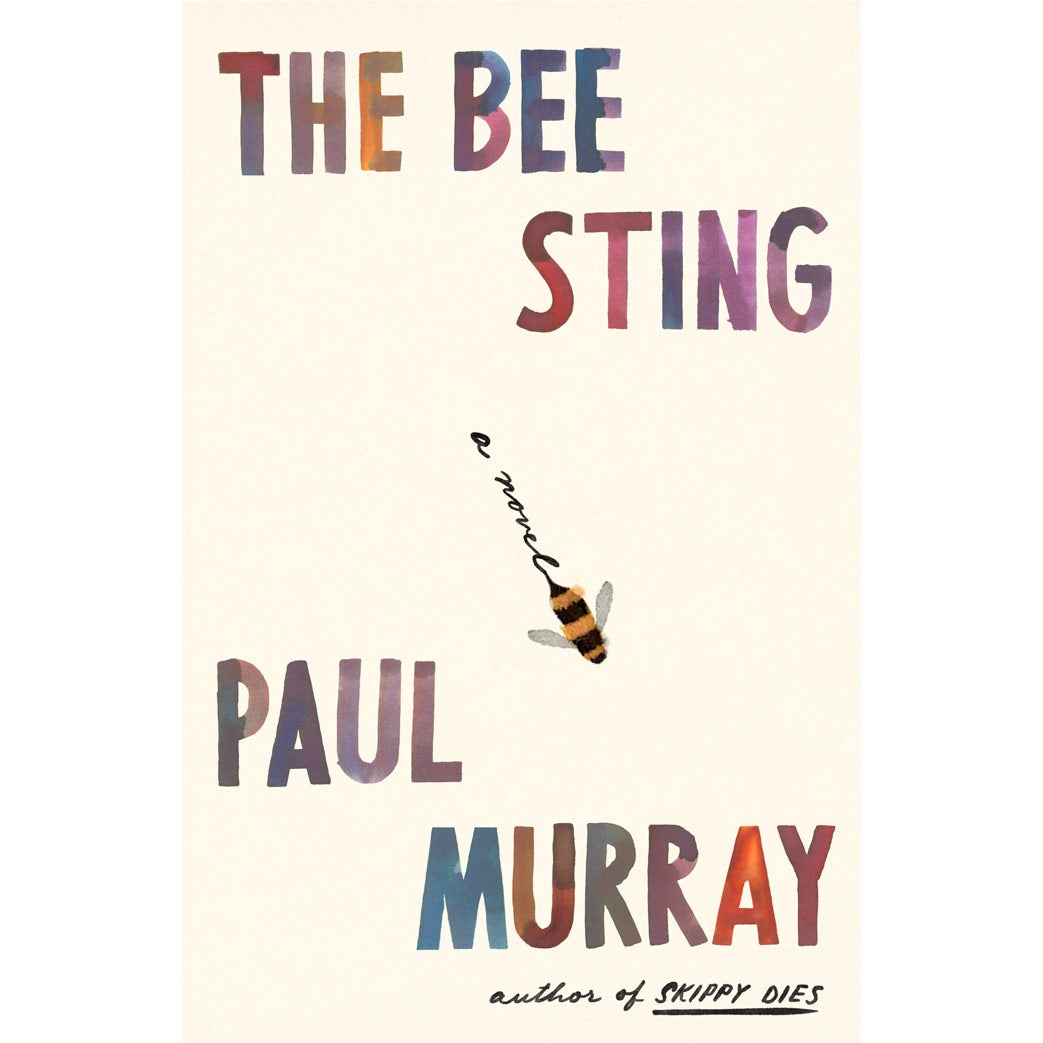What does Paul Murray think about the novel? On the one hand, he keeps on publishing great big fat ones: His ambitious new chronicle of contemporary Irish family life, The Bee Sting, is 643 pages, following on the heels of the financial-crisis comedy The Mark and the Void (480 pages) and the boarding-school epic Skippy Dies (672 pages). Presumably he spends quite a bit of his day writing novels, which would imply a certain devotion to the form.
On the other hand, Murray gives us, hundreds of pages into The Bee Sting, a literature professor at Dublin’s Trinity College delivering a stemwinder on the novel’s corrupt origins and nefarious purpose. “Today, in the developed world, the great threat to political order is that people will pay attention to their surroundings,” the teacher says. Thus, a great network of distractions has arisen to blind them to the truth. “The novel,” they warn, “was the first instance of what in the twenty-first century has become a vast and proliferating entertainment industry, an almost infinite machine designed to distract us and disempower us.”
Is that really the novelist’s goal, distraction from what is real and true? Does a novel really serve no greater purpose than, like, opiating the masses? When an author lets one of his characters—a literature professor, no less!—gas on about the novel, it’s an invitation to read carefully. Often such grand pronouncements amount to a novelist’s statement of purpose, smuggled into the fictional world—a personal pep talk she can return to now and then when she’s feeling run down. But I think Murray, who does love a good joke, is doing something funnier. He thinks the professor’s full of it. The novel, Murray believes, can help readers see clearly, listen with care, think hard. As evidence, he presents the rest of The Bee Sting, a novel that strives to engage with the world on every single overstuffed page.
Slate receives a commission when you purchase items using the links on this page. Thank you for your support.
At the center of The Bee Sting is a fable, a fairy tale about fairy folk, recalled by Imelda Barnes, wife of Dickie, mother of Cass and PJ. Imelda herself was once a kind of fairy tale, the penniless beauty who married into a wealthy family, but the Barneses have fallen on hard times thanks to the recession, which is killing Dickie’s Volkswagen dealership. Now she recalls the fable, told to her by her mysterious aunt—“a warning,” Imelda thinks, “before either of them knew there was anything to warn about.”
In the story, a weary traveler, stuck outside on a cold night, discovers a door in the side of a hill, and on the other side of the door, a great banquet hall filled with food and drink and music and fair-haired, blue-eyed folk who, when they see the traveler, “let out a cheer as if they have been waiting for him before they begin.” The traveler eats and drinks and dances, and when he wakes the next morning, cold and stiff on the side of the hill, he sees no sign of the door. And later that day he arrives at his village to find it all changed, his house a pile of stones, his wife and children long dead—for while he danced and drank, a hundred years went by, never to be regained.
I found myself puzzling over this story, one that might smack of the particular flavor of leprechauns and blarney that actual Irish people call Oirishness. It sticks out in this determinedly modern novel, one whose characters are focused on money and college and video games and climate change, from a determinedly modern Dublin novelist, whose career seems devoted to an unsentimental, unclichéd portrait of his country. And yet I couldn’t stop thinking about this poor traveler, who finds after one whirling dance that his home is forever unfamiliar to him. You have to imagine him roaming the countryside, wondering where the world he once knew had gone.
The Barnes family spends a lot of time wondering what happened to the past—that is, when they’re not stewing in their present, or being terrified about the future. Dickie’s faltering dealership touches them all. Imelda’s selling off her nicest things on eBay. PJ, 12 years old, is facing an existential threat from a local yob who thinks Dickie has stolen from him. And Cass, dreaming of college in Dublin, feels the stares from every direction in a town where there are no proper shops, no Starbucks or McDonald’s—just stupid locally owned cafés where “you can’t even buy a sausage roll without having to tell someone your life story.”
Murray’s characters struggle to disentangle their human-scale drama from larger, existential terrors: the recession that might never end; the murderer in the town next door; the hundred-year flood that tears through the village. “Nothing mattered!” Cass tells herself when, instead of studying for exams, she spends her nights hooking up with gross men in the worst of the local pubs. “Everything was coming to an end, everything was closing down, everything had been carried off in the flood.” Later, Dickie, consumed with “future-proofing” his home, reflects on that flood and the hundred-year drought that followed, and wonders: “Maybe that’s how it will go—instead of one definitive cataclysm, a series of ‘anomalies,’ each time lasting longer, with the stretches of what you call normal life becoming further and further apart, until one day it dawns on you that this is normal life now.” That’s a chilling premonition of how civilization might degrade thanks to climate change, but also a pretty apt description of what it’s like becoming an adult.
The Barnes family, too, is suffering its own series of anomalies—Cass’ drinking, PJ’s plans for running away, both parents catching the eyes of someone else—until the family also finds their world changed, unrecognizable. On Dickie’s desk at the dealership he keeps a Christmas photo of the Barneses at an amusement park five or six years before, the kids small, everyone happy, “even though PJ had got sick on the Crazy Cups.” The gulf between then and now seems unbridgeable.
Murray’s family epic alternates points of view every hundred pages or so, each family member getting his or her say, in a structure I’d call the Standard Franzen. Murray’s twist is that the voices diverge according to character: Some sections are in first person, some in third, some present tense, some past. Imelda’s sections are written in a Joycean flood that follows the torrent of her ever-streaming thoughts. The narrative dives back into the past, to the two oft-told stories that seem to have definitively turned the Barnes parents’ lives in different directions: the time Dickie, off at college in Dublin, was struck by a car and had to return home; and their wedding day, when Imelda, stung by a bee, kept her veil down through the ceremony to hide her swollen eye. Secrets about the past and the present are revealed, even as the family members grow more and more distant from one another. But one knows, reading the book, that they’ll find their way back together somehow, and indeed, the novel’s machinery sends them hurtling back toward one another at novel’s end, though not in precisely the manner you might expect or hope. In that final deluge, the book’s voices alternate in an accelerating flurry, and it might take you a few pages to notice: Murray’s writing them all in second person now. The characters are all “you.”
When recommending Murray’s earlier masterpiece, Skippy Dies, I often tell friends not to be daunted by its doorstop-ness. The book is so inventive, so funny, so extravagantly entertaining, that to worry there’s too much of it is like worrying that one’s marriage might be too happy. What a problem to have! In The Bee Sting, Murray is working in a less fizzy, more portentous mode, and there were times I missed the puckish humor that kept Skippy’s motor running. (You still see it pop up now and then, dry and irresistible, as when Imelda recalls Dickie’s new-money father roaming his estate, “pointing to ‘notable trees’ with his stick.”) But if The Bee Sting is a little more serious, well, we live in serious times, and it’s heartening to have a writer with Murray’s energy devoting such attention to contemporary life.
The Bee Sting is 645 pages of close observation, encouraging readers to identify the disconnections and miscommunications that plague us all, the small personal disasters that our fear and dishonesty transform into apocalypses. Contra Cass’ teacher’s cynical view, the novel can and should help us pay attention to the now. For what is the alternative? Our lives spent in dreams, dancing and drinking, or in nightmares, cowering in fear—only to awake and find the world in which we were happy is gone forever? Imelda drives, one dark afternoon, into the countryside and finds that the yellow hills, the old landmarks, all Ireland, provide no answer to the problems that plague her: “At the crossroads a shuttered pub a blackened sign Guinness Time the country gazes back at you like a mirror with nothing in it.”

